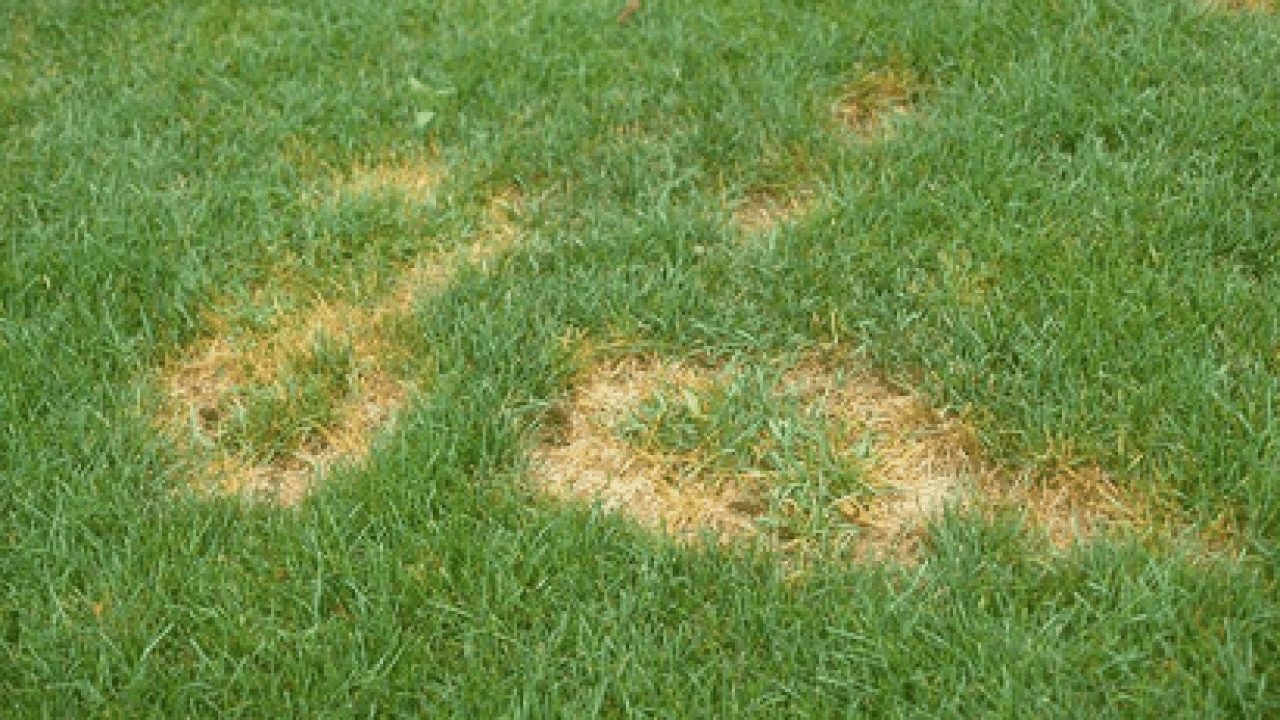
Does your lawn look like this?
One of the most common diseases encountered is summer patch, a soil-borne condition that targets Kentucky bluegrass during the summer heat. The damage from summer patch manifests as incomplete rings of discolored or dead turf, typically with a patch of live turf in the center. This disease is sometimes dubbed “frog-eye” due to its appearance.
Several conditions promote the development of this disease:
- Lawns grown on compacted soil are much more likely to show signs of summer patch, as their root structure is stunted and is more adversely affected by the stress of heat and humidity.
- Excessive thatch buildup also encourages summer patch development. Thatch prevents water from reaching the soil and acts as a sponge that holds moisture. Regular aeration, especially on sodded lawns, is highly recommended to both alleviate compaction and help remove excessive thatch.
- Lawns that are watered lightly and frequently are more susceptible to disease. Diseases favor humid conditions, and a frequent irrigation schedule doesn’t allow the turf or thatch layer to dry out as it should. The rule of thumb when watering turf is “deep and infrequent”. The goal is to provide about ½” of water through irrigation, then not water again for 3-4 days or until the turf needs it.
- Low mowing height puts undue stress on turf and makes it susceptible to all weeds, pests and diseases, not just summer patch. Mowing heights of at least 3” are recommended throughout the growing season. During times of extreme heat or drought, raising the mowing height to 3.5” is good practice.
- Recent research has shown that summer patch tends to be more of an issue in soils that are lacking certain nutrients. There are 15 nutrients necessary for turf growth, and most of them are present in the soil. Different soil types are abundant or deficient in certain “micronutrients” (elements that aren’t needed in great supply), and soil tests will tell us exactly what is needed.
We typically see summer patch in sodded lawns that are 2-3 years old (although it certainly is an issue for golf courses and athletic fields too), and it is a condition that eventually goes away (research suggests 7-10 years). Over time, the soil builds up defenses and immunity to it, but it can be unsightly until then. Summer patch becomes active when soil temperatures reach 65 degrees, but it only shows itself during period of more extreme heat and humidity when lawns are under more stress.
Control of Summer Patch
Whenever we’re encountered with a pest or disease, there are two treatment options; chemical and cultural. Chemical control involves using pesticides or other compounds to eradicate an unwanted disease. Cultural practices involve a variety of management techniques meant to change the environment, so a pest won’t survive or find favorable conditions. We outlined a few earlier, but it would be useful to go over those again!
Cultural Controls for Summer Patch
- Aerate regularly to alleviate soil compaction and help prevent thatch build-up.
- Irrigate infrequently, and when you do irrigate, try for a deep watering of ½” water.
- Raise mowing height to at least 3”, and in times of extreme heat or drought, raise mowing height to 3.5”.
- Maintain consistent nitrogen fertilization throughout the season to avoid periods of time where the grass is starved for nutrition or excessively fertilized.
- Maintain a soil pH around 6.5. This can be found with a simple soil test. Some “old wives tales” suggest adding lime to the soil every year to raise its pH. We rarely encounter soils with low pH in this part of the country, and a lime application is not likely to be needed.
Chemical Controls for Summer Patch:
Regular fungicide applications can effectively combat summer patch. However, for the average home lawn, this approach isn’t practical. Such applications can be costly and require reapplication every 14-28 days. This regimen is more typical for golf course putting greens or high-maintenance athletic fields.
As mentioned earlier, summer patch and other diseases tend to favor lawns that are deficient in certain micronutrients. At UltraLawn, we’ve helped customers with summer patch by making supplemental applications of micronutrients. This program is aimed at modifying the soil, which takes some time to accomplish. We’ve noticed that summer patch damage is less severe and recovers faster after one year of micronutrient applications. After two years, we can achieve near-complete control. These applications must go in conjuncture with the proper cultural practices outlined earlier.
As more university research is done on summer patch and information is gathered, we at UltraLawn will continue to pass our knowledge and expertise on to our customers. If you suspect that your lawn has summer patch or have any other questions or concerns, feel free to give our staff a call!


No comment yet, add your voice below!